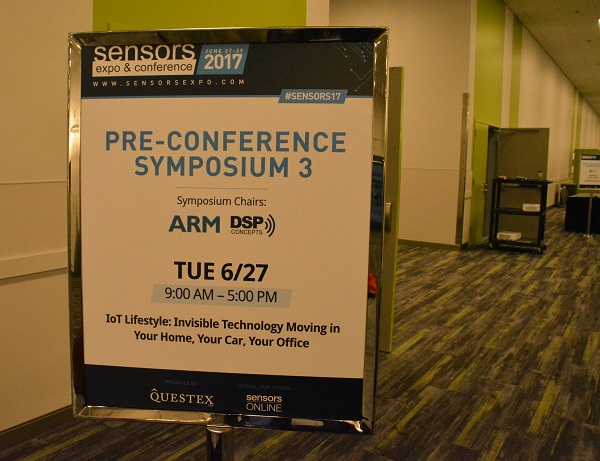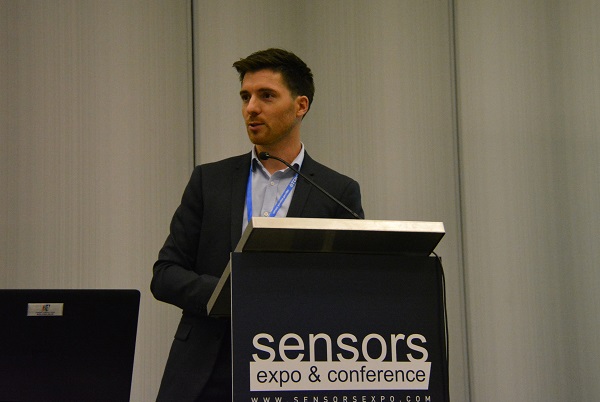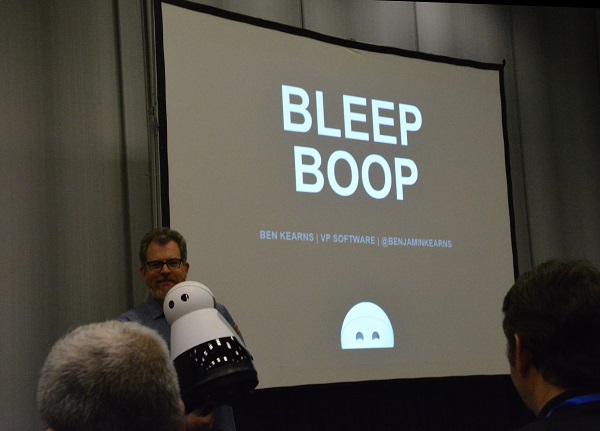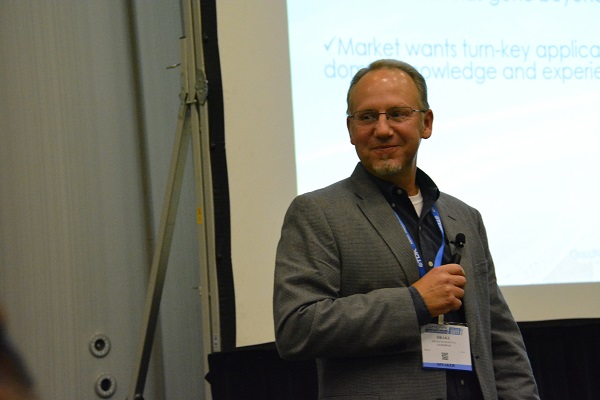by Dot Cannon
How is the Internet of Things lifestyle evolving today? And how can “smart” or “connected” devices become a regular part of everyday life–to the point that the technology becomes unnoticeable?
These were the questions which a series of speakers explored, at Sensors Expo 2017’s recent Pre-Conference Symposium 3, “IoT Lifestyle: Invisible Technology Moving in Your Home, Your Car, Your Office” on June 27th in San Jose’s McEnery Convention Center.

During Tuesday morning’s sessions, the speakers had discussed some of the challenges facing a “connected” world. Lack of standardization, cost and privacy issues all represented obstacles, they agreed.
But, they said, the Internet of Things offered considerable rewards, as well. These included the ability to create “smart” home robots, and to monitor asthma patients’ coughs with a device that would warn of an impending asthma attack.
The Analysts’ Views

Now, the afternoon sessions were beginning. Pre-symposium organizer and moderator Will Tu, who is DSP Concepts‘ VIce-President of Business Development, introduced the first event: an “Analyst Face-Off” panel discussion.

“Speech recognition has been around for many years,” said Peter Cooney, Principal Analyst and Director of SAR Insight & Consulting, as the panel began. “Voice is (now) becoming a key interface.”
But, he said, users were so accustomed to using touch screens that they’d require a learning process, to accept voice-activated devices. Still, he saw the technology making progress.
“We’re expecting around ten million voice-controlled ‘smart’ speakers will ship this year,” he continued. “Smart speakers are becoming the keystone for the overall smart home.”
However, a number of factors are currently holding back that progress. Peter named security and privacy concerns as central issues–but added that technology provided ways to minimize the risks.

“There’s a button to turn off audio so users can erase (unwanted recorded) information,” he said. “But it’s clear that more is needed to protect consumer confidence in using voice. Another piece in the (security) armory is voice biometrics.”
Voice biometrics, he explained, allowed a “smart” machine to digitize a person’s speech and respond to that individual’s unique voice print. And a number of industries were now starting to implement voice biometrics, including banking, insurance and health care. But while Peter said home use of voice biometrics was a possibility, he added that the technology needed to mature further.
“(There are) a lot of key hardware and software blocks that need to be implements, too,” he commented. “It’s clear that many technologies need to come together to drive the growth of voice as a primary interface.

“I truly believe, with the acceleration pace of technology, that voice will be the primary interface within the next ten years. I think it’s up to all of us to help that vision become a reality.”
Consumer vs. commercial IoT

“There is no pot of gold,” commented TIRIAS Research Principal Analyst Kevin Krewell, in his introductory remarks.
The consumer market for the IoT, he said, was “fragmented and would continue to grow slowly”.
But, Kevin continued, serving businesses was an area where the IoT had considerable future potential.
“It’s maybe not as sexy as a home thermostat, but I think you’ll find real value there,” he said. Illustrating his point, he asked the audience,
“How many people have an Amazon or a Google Home?” A number of people responded that they did.
“How many use it every day?”

About six hands went up, in response, in the filled-to-capacity room. “(And) I have one, but I don’t use it every day,” Kevin continued.
Future industrial uses of the IoT, he said, could include using sensors to track grain or milk production and detect spoilage. But the area to watch, he said, was the automotive industry.
“We’re about to go through a whole new generation of voice interfaces in the car,” he said. “And in fact, autonomous cars are going to be very vocal…We’re about to go through another phase of IoT connectivity through cellular networks. There’s a lot more capability than there was in the past.
“The really bleeding edge of IoT is (automotive technology).”
The approaching wave

Yole Developpemente Market and Technology Analyst Guillaume Girardin addressed the rapidity with which technology was advancing. “We think we had the first wave of technology start in 1980,” he said. “Now we’re in the second wave, with some disruptors.
“We think the third wave is coming…maybe in seven or eight years. We don’t know yet what device will coordinate (connecting all the IoT functions). We feel each wave is more and more important, (and) it happens quickly,” Guillaume commented.
A move towards smaller, smarter and cheaper technology was what was driving the IoT market, he said. “If you look at the average price of sensors since 2000, you see a huge (price) decrease,” he continued. “New devices like Sony earbuds bring functionality to old devices (and) we think those (new) devices are here to train the (artificial intelligence).”
“In the future,” Guillaume predicted, “I think you won’t have many, many devices in your house, but it will be merged with a single robot.”
Questions, answers and predictions

“Peter, can (voice-recognition software) enhance the ability to drive a car?” Will wanted to know.
“These systems are always learning,” Peter replied. “So that’s a really good example of how that kind of thing could help.”
Next, Will and the panel discussed wearables.

“There’s a lot of research being done now (on implantable devices),” Peter said. “Perhaps the biggest issue, at the moment, is battery life. I think we’re a long way from that, but in about ten years or so we should be seeing (implantable devices) come on the market.”
An audience member asked, “What’s really new with voice activation, if it’s been around a long time?”
The difference, Peter said, was that large companies had been spending large amounts of money, in the past five years, buying up smaller companies and combining the technology.
“All these companies are vying to be the biggest name in voice activation,” he explained. “It will be ubiquitous.”

And the automotive industry, the panel said, had the potential to drive growth of IoT development, due to the sheer volume of sensors in autonomous vehicles.
One question that came up: What’s the primary reason people aren’t using voice activation?

“We haven’t made it quite easy,” Kevin commented. “(In a vehicle,) you’ll think of it as a machine and you don’t always trust machines.”
Also, he said, speakers currently don’t distinguish between voiceprints. “Right now, anybody in the home could use it to order something.”
“What’s the next big sensor?” Will asked.

“According to (Yole Developpement), it’s the 3D camera,” Guillaume replied.
Peter and Kevin agreed that 3D would be big. “They’re mostly going to be glasses, and (mostly) immersive AR,” Kevin said. “You have to sense this table so you can place a virtual object on it. That’s what’s happening in automotive. It’s rarely just one sensor (but a number of them together). One of the biggest challenges right now is fusing all of these together.”
A “rock star” robot
Following a short break, this reporter–and a number of other attendees–predictably fell “In Love with an Adorable Home Robot”–as the next session was named!
“We focused on making the technology disappear,” said Mayfield Robotics Vice President of Software Ben Kearns, as he introduced “Kuri”.
“What we focused on, is how the robot can make you feel.”

This decision to create a “cute” robot, Ben explained, was based on consumer testing. “We’ve taken a bunch of sensors and…tried to combine (them) into something you want to bring into your house. Sensors themselves are not cute.”
Although the “Kuri Home Robot” was originally designed for home security, Ben said it–or, rather, she–evolved into an autonomous companion. Kuri can stream music or audio books, give reminders and alert residents if she spots something out of the ordinary.

“We’re focused on what technology can make a robot feel, not like a toy, but a pet or a member of your family,” Ben continued.
Ben explained that he and his team made a conscious decision to have Kuri communicate in beeps and boops, rather than actual speech. “Expectations are raised if she can actually speak,” he said.
Kuri ships later this year, and Ben said she’s designed “for people who have grown up dreaming about the day when they can have a robot in their house.”
“We’re trying to make her feel like she’s alive,” he commented, before telling the audience that his wife was sold on having a robot in the house when she discovered Kuri could follow her and stream her favorite public-radio programming.

“Kuri can notify you when your kids come home,” Ben said. “We can’t currently customize (her) but we will probably do that after our first little batch.”
In the testing phase, he added, he himself had experienced the empathy he and his team wanted to create for Kuri.
“We had an open house, where a bunch of kids put her in a pen where she couldn’t get out. (She was making beeping and booping sounds, since she’s programmed to go back to her charging pad and couldn’t get to it.)
“That’s the only time in my life I ever felt sorry for a piece of technology.”
Sensors and Health 
“What does the ideal sensor look like, to an IoT engineer?…What does the future look like?” Reuleaux Technology CEO Scott Nelson began.
In the next few minutes, during his presentation, “How to Make More-Than-Moore in the Internet of Things”, he would answer these questions by telling the audience that affordable, and small–to the point of disappearing–were the goals.
(That “More-Than-Moore” is a reference to Moore’s Law. Simply stated, Intel co-founder Gordon Moore observed, in 1965, the rate at which processing power was increasing. Moore approximated that the number of transistors on a chip would double every two years, according to Intel’s webpage.)

“Sensors which are basically thin films (will) go into (future) tires,” Scott said. “They’re going to disappear.”
But the most exciting innovation, he said, involved digital health care.
“In my world, the next generation is going to be bio-sensing,” Scott commented.

Currently, Scott told his audience, digital health equaled measuring data. But monitoring, not measuring, would be the trend.
“If you’re a sensor company looking at health care, this is the future,” he said, displaying a wearable monitor. “This device goes into the heart without (cutting it).”
And those wearables, he said, could monitor other functions–including the bladder, and tissue changes in chemotherapy patients. Cost of the devices would be low, and they would have a ten-year life while monitoring the data important for the wearer.
“The IoT changes the equation.”
Fusion for the next generation
In his presentation, CloudNav CEO Drake Margiotta discussed a solution to a previously-raised problem in developing the IoT: how to get different devices to work together?
“Limitations are actually solved by the sensor fusion,” he said. “…The amount of memory you need, is based on what you’re trying to do with it. A sensor inside a football has to be completely different than the one inside the phone.
“All of the sensors have issues, the algorithms have issues, and there’s also trade-off.”
Another challenge, Drake explained, was that sensor fusion should always be on.

“The next question is, what are you going to sense?”
The foremost use of sensors, he said, would be in the health-care field.
“I had three back surgeries, (and) had to go to therapists (for examinations). You can do the same things at home with sensors,” he said.
And the second-largest area for sensor use: “sports-type stuff”.
“(Sensors can) analyze speed, movement and get information back to the athlete.”

CloudNav, he said, had made a number of performance products, using various types of sensors.
“Pedometers, we (made) five (different types). Sometimes people don’t care about accuracy at all. The other ones, for sports, (are ninety-nine percent accurate).”
In addition, Drake continued, CloudNav’s pedometers are customizable–and can even be customized to pets!
Gesture control was another area in which they’d been working, he said, as was voice command.
“(With) wearables, people want to know, ‘can you give me four speaker controls?'”
“There’s a bunch of different ways to do (sensor fusion). Lots of platforms,” Drake concluded.

The afternoon was winding down. And Sensors Expo 2017’s Pre-Conference Symposium #3 had offered some important takeaways:
- Currently, devices that may ultimately be connected are “speaking different languages”. Standardization will be essential, in developing the Internet of Things.
- Additional security safeguards will be crucial to the IoT’s growth.
- And, more than anything, community and collaboration are key. “No one does the Internet of Things alone,” a number of the day’s speakers had emphasized.

“Today, what I was hoping to give you was a program (that comprehensively covered the aspects of developing a “connected” world,” Will said in his closing remarks. “With…current technology, Moore’s Law is not necessarily the answer.
“The challenge you’ve got, is to use data to make the sensors do something that’s really smart.”
